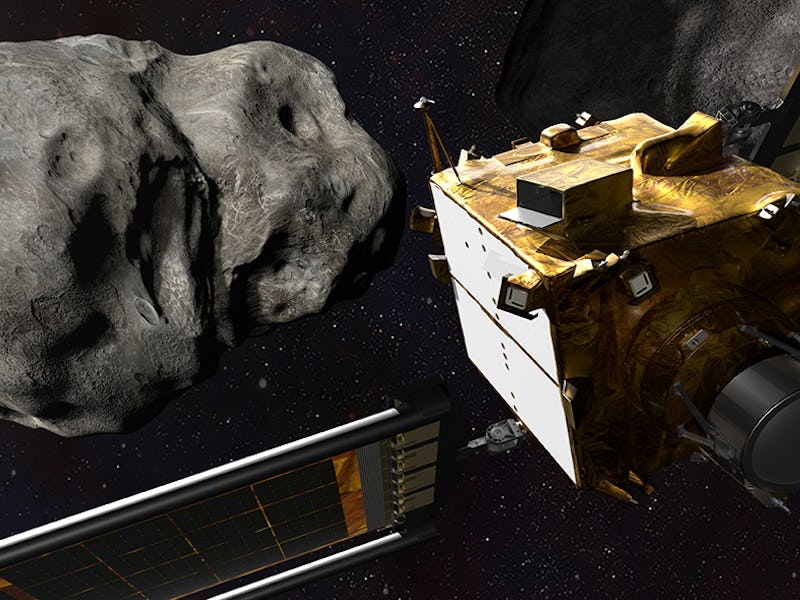NASA’s DART Mission Snapped Pictures Until It Crashed Into An Asteroid. Here’s What Those Images Reveal
NASA got up close and personal to an asteroid pair near Earth.

NASA’s Double Asteroid Redirection Test (DART) made history almost two years ago. This was the first time humanity attempted to intentionally alter the motion of a space rock. They succeeded.
A spacecraft slammed into the tiny moon of an asteroid, all while its onboard camera and an Italian robotic onlooker called LICIACube snapped photos.
The footage is a treasure trove. On Tuesday, teams published five scientific papers in the journal Nature Communications. Each contains new insights into what these rocks are like, and how tricky it may be for future planetary defense missions to strike another asteroid to avoid an impact’s calamity on Earth.
Behold the final five-and-a-half minutes before DART intentionally collided into asteroid Dimorphos.
Here are five discoveries about this binary asteroid system so briefly encountered on September 26, 2022.
1. The larger asteroid has an older surface than the little moon.
Didymos and its moonlet Dimorphos are related to one another. But scientists still don’t know exactly how. One investigation looked at 16 craters on the larger asteroid, Didymos.
DRACO, the Didymos Reconnaissance and Asteroid Camera for OpNav scientific camera, was one image source. It took many photos of Didymos and smaller Dimorphos before impacting the latter’s surface.
The craters suggest that the Didymos surface is about 12.5 million years old. But the Dimorphos surface is a fraction of that, only about 90,000 years to 300,000 years old.
2. Didymos is a pile of rubble.
Observations confirmed theoretical expectations: It’s essentially a clump of leftovers from a catastrophic event in the ancient past.
Scientists noticed Didymos boulders appear too large to have been excavated by whatever made the craters. Something grander was responsible, and its mess, rounded up through gravitational attraction, is now Didymos. The large boulders are heirlooms passed down from an ancient parent rock.
This image from Italy’s LICIACube show the plumes of ejecta streaming from the Dimorphos asteroid after NASA’s DART made impact. Each rectangle creates a different level of contrast. This helps viewers to better see the plume’s fine structure.
3. We need to know much more about fractures on Dimorphos’ boulders.
Asteroid boulders live in an airless environment. But, they can be altered through thermal fatigue. As the Sun shines on them, cracks form.
The Dimorphos fractures were identified with the help of independent contributors who located them across boulders of different sizes. This work adds to what’s already been gleaned about the Near-Earth asteroid population from previous NASA, Japanese, and European missions.
The picture emerging from the data is that, should a kinetic impactor like DART slam into another space rock, the thermal cracks “may contribute to an enhancement in the ejected mass,” one study says.
4. Eclipses may be ongoing.
On the flip side, eclipses could be having an opposite effect: cooling rocks down.
This animation shows how Dimorphos’ orbit around Didymos was seen from Earth about one week after the DART impact.
Based on limited data about how Dimorphos now spins after DART struck it, scientists think the moonlet remains tidally-locked to Didymos. This means Dimorphos shows the same face to Didymos, like the Moon does with Earth. If this relationship is fostering eclipses, a periodic drop in temperature could be happening on the asteroids.
Like thermal fatigue from solar radiation, the cooling effect of eclipses must also be factored into deflection techniques. This asteroid duo provides a unique chance to investigate this. Other closely-studied asteroids and comets have no companion to block out light.
5. The Didymos surface is weaker than dry sand on Earth.
One major thing researchers want to know before visiting any celestial object is how much weight you can put on it. This is called bearing capacity. It reveals a lot about the formation history of the Solar System. And in the case of planetary defense, bearing capacity also informs how to build something that can effectively knock a space rock off a collision course with Earth.
“The low surface strength of Dimorphos likely contributed to DART’s significant impact on its orbit,” NASA officials wrote in an announcement published Tuesday. This also seems to be a trait of the larger asteroid, Didymos.
Researchers looked at DRACO’s final full image of Didymos before it slammed into the moonlet Dimorphos. DART didn’t touch Didymos. But boulders on its surface left tracks. Scientists studied nine of these paths. They determined that the bearing capacity of Didymos is “at least 3 orders of magnitude less than the bearing capacity of dry sand on Earth, or lunar regolith [dirt].”
Researchers have already learned so much about Near-Earth asteroids from the DART mission. Thanks to the European Space Agency’s upcoming Hera mission to survey the duo in October 2026, even more discoveries could emerge.